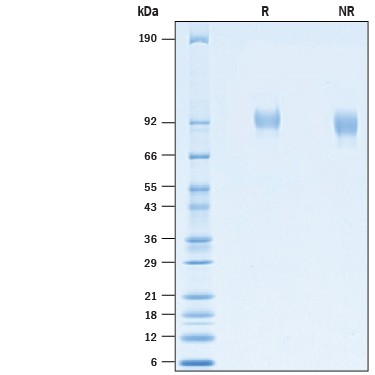Recombinant SARS-CoV-2 Spike S2 (GCN4-IZ) His Protein, CF
Recombinant SARS-CoV-2 Spike S2 (GCN4-IZ) His Protein, CF Summary
Product Specifications
| SARS-CoV-2 Spike S2 Subunit (Ser686-Lys1211) Accession # YP_009724390.1 | GCN4-IZ | HHHHHH |
| N-terminus | C-terminus | |
Analysis
Product Datasheets
Carrier Free
CF stands for Carrier Free (CF). We typically add Bovine Serum Albumin (BSA) as a carrier protein to our recombinant proteins. Adding a carrier protein enhances protein stability, increases shelf-life, and allows the recombinant protein to be stored at a more dilute concentration. The carrier free version does not contain BSA.
In general, we advise purchasing the recombinant protein with BSA for use in cell or tissue culture, or as an ELISA standard. In contrast, the carrier free protein is recommended for applications, in which the presence of BSA could interfere.
10590-CV
| Formulation | Lyophilized from a 0.2 μm filtered solution in PBS with Trehalose. |
| Reconstitution | Reconstitute at 500 μg/mL in PBS. |
| Shipping | The product is shipped at ambient temperature. Upon receipt, store it immediately at the temperature recommended below. |
| Stability & Storage: | Use a manual defrost freezer and avoid repeated freeze-thaw cycles.
|
Scientific Data
 View Larger
View Larger
2 μg/lane of Recombinant SARS-CoV-2 Spike S2 Subunit (GCN4-IZ) His-tag (Catalog # 10590-CV) was resolved with SDS-PAGE under reducing (R) and non-reducing (NR) conditions and visualized by Coomassie® Blue staining, showing bands at 80-100 kDa.
Reconstitution Calculator
Background: Spike S2 Subunit
SARS-CoV-2, which causes the global pandemic coronavirus disease 2019 (Covid-19), belongs to a family of viruses known as coronaviruses that also include MERS and SARS-CoV-1. Coronaviruses are commonly comprised of four structural proteins: Spike protein(S), Envelope protein (E), Membrane protein (M) and Nucleocapsid protein (N) (1). SARS-CoV-2 Spike Protein (S Protein) is a glycoprotein that mediates membrane fusion and viral entry. The S protein is homotrimeric, with each ~180-kDa monomer consisting of two subunits, S1 and S2 (2). As with most coronaviruses, proteolytic cleavage of the S protein into two distinct peptides, S1 and S2 subunits, is required for activation. The S1 subunit is focused on attachment of the protein to the host receptor while the S2 subunit is involved with cell fusion (2-4). A metallopeptidase, angiotensin-converting enzyme 2 (ACE-2), has been identified as a functional receptor for SARS-CoV2, similar to SARS-CoV-1, through interaction with a receptor binding domain (RBD) located at the C-terminus of S1 subunit (5, 6). The S2 subunit of SARS-CoV-2 shares 90% and 41% amino acid sequence identity with the S2 subunit of SARS-CoV-1 and MERS, respectively. It has been demonstrated the S Protein can invade host cells through the CD147/EMMPRIN receptor and mediate membrane fusion (7, 8).
- Rota, P.A. et al. (2003) Science 300:1394.
- Bosch, B.J. et al. (2003). J. Virol. 77:8801.
- Belouzard, S. et al. (2009) Proc. Natl. Acad. Sci. USA 106:5871.
- Millet, J.K. and G. R. Whittaker (2015) Virus Res. 202:120.
- Li, W. et al. (2003) Nature 426:450.
- Wong, S.K. et al. (2004) J. Biol. Chem. 279:3197.
- Wang, X. et al. (2020) https://doi.org/10.1038/s41423-020-0424-9.
- Wang, K. et al. (2020) bioRxiv https://www.biorxiv.org/content/10.1101/2020.03.14.988345v.
FAQs
No product specific FAQs exist for this product, however you may
View all Proteins and Enzyme FAQsReviews for Recombinant SARS-CoV-2 Spike S2 (GCN4-IZ) His Protein, CF
There are currently no reviews for this product. Be the first to review Recombinant SARS-CoV-2 Spike S2 (GCN4-IZ) His Protein, CF and earn rewards!
Have you used Recombinant SARS-CoV-2 Spike S2 (GCN4-IZ) His Protein, CF?
Submit a review and receive an Amazon gift card.
$25/€18/£15/$25CAN/¥75 Yuan/¥1250 Yen for a review with an image
$10/€7/£6/$10 CAD/¥70 Yuan/¥1110 Yen for a review without an image
